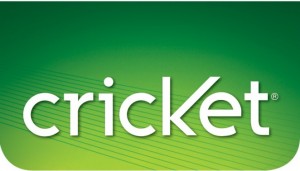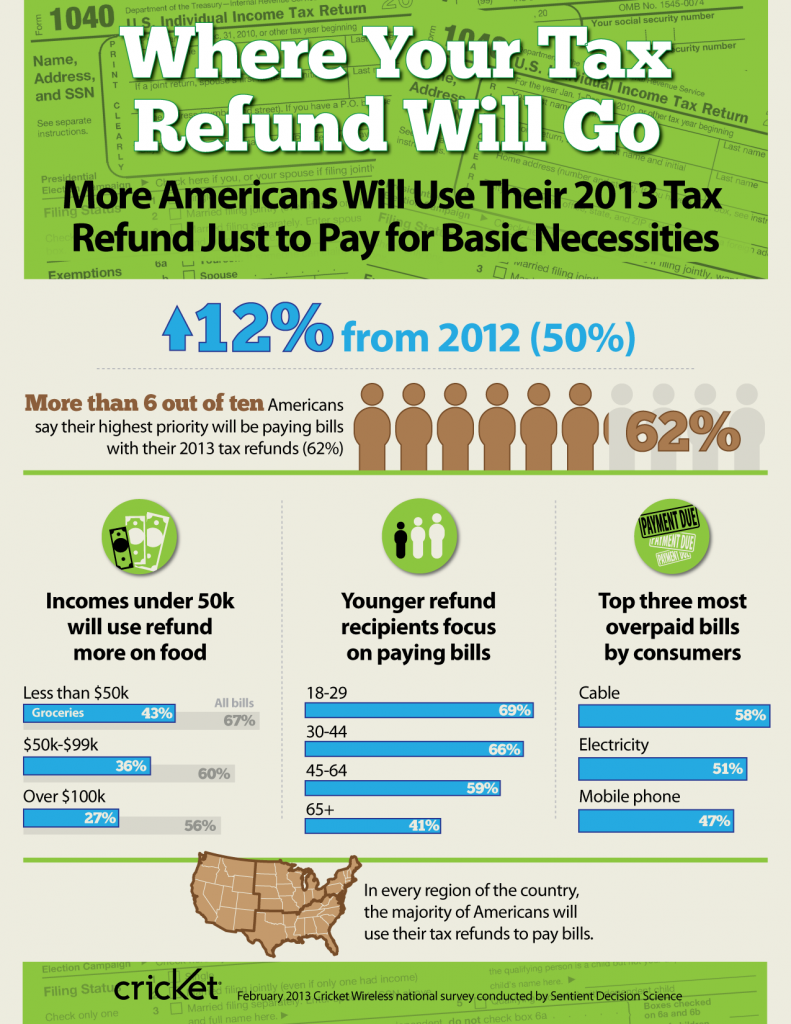 This tax season, nearly two-thirds of Americans report paying bills as the highest priority for spending their refunds, according to a recent Cricket Wireless survey*, a sharp increase from 2012 (50 percent). In fact, in every region of the country, more than half will spend their tax refund to pay bills – Northeast (65 percent), South (65 percent), Midwest (60 percent) and West (59 percent). Of these, younger people are feeling the highest pressure on their basic necessities, with 69 percent of 18-29 year-olds reporting bills as their main concern.
This tax season, nearly two-thirds of Americans report paying bills as the highest priority for spending their refunds, according to a recent Cricket Wireless survey*, a sharp increase from 2012 (50 percent). In fact, in every region of the country, more than half will spend their tax refund to pay bills – Northeast (65 percent), South (65 percent), Midwest (60 percent) and West (59 percent). Of these, younger people are feeling the highest pressure on their basic necessities, with 69 percent of 18-29 year-olds reporting bills as their main concern.
With nearly three-quarters of Americans considering a wireless phone (72 percent) to be a household necessity, just slightly behind computers (78 percent) and well ahead of other items like cable/DVR (48 percent), books (39 percent), tablets (17 percent), it is no surprise that 47 percent of consumers feel like they have no control over what they spend every month on their wireless plan.
Additionally, Cricket’s recent consumer poll finds 47 percent of consumers feel they are overpaying for their wireless phone. This consumer sentiment can be directly correlated to the nearly 50 percent of Americans who report that worrying about penalty charges causes them to buy a plan with more wireless minutes and data bucket allowances than they actually need. This is especially true among smartphone users (52 percent) compared to all other wireless phone users (34 percent).

“While the growing number of smartphone users is evident, we are also seeing a shift in consumer attitudes about the importance of reevaluating their wireless phone spending,” said Nathan South, vice president, customer experience and forecast analytics for Cricket Communications, Inc. “Based on our recent survey findings, we see that consumers no longer want to be told what they want; but rather, want to decide what they need for themselves and are more frequently considering prepaid options. It now comes down to education.”
Recognizing that wireless phone plans (47 percent), along with cable (58 percent) and electricity (51 percent), are considered the top three most overpaid bills by consumers, Cricket is providing solutions to cut costs and avoid common wireless phone money mistakes.
To help educate wireless users on ways they can cut back on their phone bills, Cricket provides some simple tips this tax season:
Rethink Wireless Phone Contracts:
With the typical contract for postpaid wireless phone plans lasting two years, it is easy for consumers to overlook what they’ve committed to and become overburdened with locked in costs. In fact, according to a recent national survey conducted by Cricket Wireless, 57 percent of postpaid wireless phone subscribers feel they overpay for their monthly wireless bills.
As a result of this sentiment, a majority of postpaid wireless subscribers say they are more apt to switch to prepaid than they were two years ago, if they could cut their bill in half. Cricket Wireless offers unlimited plans starting at $50 – half the price of AT&T and Verizon – to help people choose what they need in talk, text and data without ever worrying about overages or contracts.
Purchase the Right Device/Handset:
Don’t get caught up in the hype of a new wireless phone launch, which may result in overpaying for a device/handset. Before buying a new device, take an inventory of how you’ve historically used your wireless phone and service. What functions for your phone do you most often use? Do you listen to a lot of music? Are you a texter or a talker? Purchase the wireless plan that matches your needs in order to save money every month.
When contract renewal is up for a customer, postpaid (contract) carriers often provide a device discount incentive to re-lock customers into another two-year contract with high monthly bills, while prepaid carriers typically charge upfront for the cost of a device and offer lower monthly fees. However, 78 percent of consumers actually indicate they would pay more for a phone upfront if their monthly wireless phone bill would be cut in half, according to a recent consumer poll on behalf of Cricket.
“As Americans continue to do their best to get by and keep their personal finances organized, Cricket is a community resource they might not have considered to make a significant difference in their monthly bills,” said South. “At Cricket, we want to provide consumers with cost savings through our no-contract options, so they can do more with the money they save.”
Wireless users switching to Cricket’s no-contract service can see their monthly wireless bills reduced by half from AT&T and Verizon wireless contracts. In fact, Cricket’s rate plans offer greater choice and flexibility in unlimited wireless service plans. Customers have more access to the features they want such as unlimited talk, text, music, data and 1-5 GB of full-speed data per month, for less money than postpaid (contract) carriers like AT&T and Verizon. Cricket also offers the newest smartphones, like the iPhone 5 and Samsung Galaxy SIII.
For more information about Cricket’s dynamic service and newest device lineup, visit www.mycricket.com. To follow Cricket’s recent news and updates online, visit Facebook at www.facebook.com/cricketwireless and Twitter at http://www.twitter.com/cricketnation.
About Cricket
Cricket is the pioneer and leader in delivering innovative value-rich prepaid wireless services with no long-term contracts. Cricket offers nationwide wireless voice and mobile data services over high-quality, all-digital 4G LTE and 3G CDMA wireless networks. Cricket’s innovative products and services, including the award-winning Muve Music® – the first music service designed for a wireless phone, are available nationwide at Cricket branded retail stores, dealers, national retailers and at www.mycricket.com. For more information about Cricket, please visit www.mycricket.com.
* According to a survey conducted by Sentient Decision Science in February 2013 on behalf of Cricket Wireless (2,358 consumers surveyed; overall margin of error +/- 2%)
